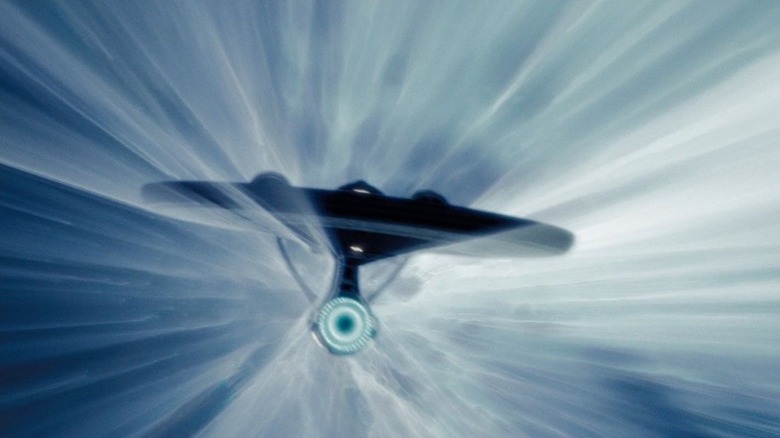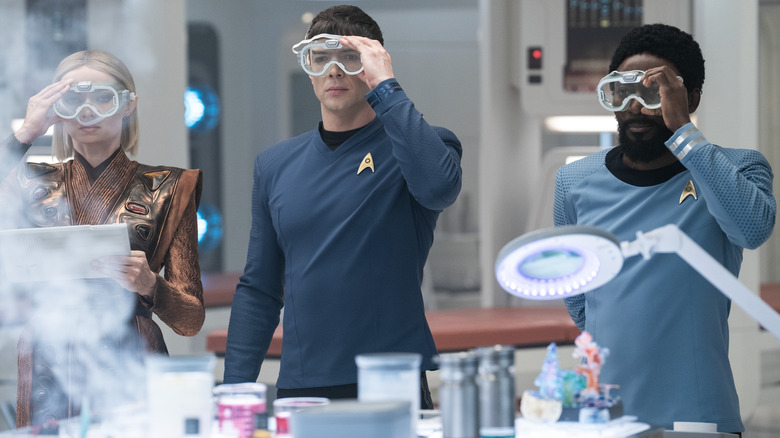Throughout its nearly 60 years of movies and shows, “Star Trek” has featured high-tech communications devices that vaguely resemble old-school flip phones, magical replicators that can conjure up any known object at will, and a galaxy full of aliens that look like humans (although there’s a solid canon reason for that now). But for every visor or turbo lift that requires passengers to grab a handle, there are countless other gadgets and theories that have actual scientific basis. Today, one of the most far-fetched could be closer than ever to becoming a reality.
Even the most casual “Trek” fans have heard of the warp device that allows various Federation ships to jump into space in the blink of an (relative) eye. There’s a reason faster-than-light travel has remained a staple of science fiction for over a century, after all. Space is very, very big and humanity has always dreamed of venturing very, very far. But until now, this technology has not only been considered beyond our reach: it is downright impossiblebecause it would defy all the laws of physics as we know it. The biggest of all? You will not travel faster than light, the universally accepted speed limit of the universe.
Turns out it might be time to go back to the drawing board. According to a recent National Geographic article, there might be a way to turn this particular fiction into reality…and “Star Trek” might end up being one of the main reasons why. Astrophysicist and warp drive researcher Alexey Bobrick was quoted as saying, “It’s amazing how science fiction writers imagine things, and then we understand that they can work.” It’s really very beautiful. »
How does Star Trek’s warp drive work anyway?
Believe it or not, it seems that Gene Roddenberry (famous for his adherence to the rules) and his writers of “Star Trek: The Original Series” were ahead of their time. While visually similar to the way, say, the Millennium Falcon travels through hyperspace in “Star Wars,” the use of the warp drive in “Star Trek” is much closer to aligning with real-world physics than we might have expected.
Under this franchise’s invented rules, the warp drive essentially works by bending spacetime around a moving ship into a bubble, which is then accelerated to speeds that far exceed the speed of light. (This is definitely an overly simplistic version, as it involves far too much math and decimal points to properly explain here. I’ll leave that to the fan wikis, thank you very much.) Compared to other sci-fi properties that rely on wormholes or slipstream methods or whatever, “Trek” manages to avoid the pesky problem that a certain genius named Albert Einstein proposed – namely, the theory of relativity which states no objects in the known universe can physically travel faster than light. Although this appears to include objects such as spaceships, “Trek” posits that it is not the USS Enterprise that is being warped at impossible speeds, but real space-time.
This technicality is apparently the key. And we’ve seen this in live action before, as shown in a gloriously cheesy shot in 2016’s “Star Trek Beyond” (and taken from actual physics, as explained at Trek Core here). National Geographic spoke with “Trek” science advisor and astrophysicist Erin MacDonald, who explained:
“If you wrap your ship in the fabric of space-time and that fabric goes faster than light, taking you with it, that doesn’t break any laws of physics.”
Science still has a long way to go to catch up with Star Trek… but it’s getting closer
Okay, just to be clear, we’re not enough to the point where we can all enroll in Starfleet Academy and venture to the stars with wide eyes and clear hearts… but we’re getting a little closer! The National Geographic report goes on to explain that the biggest obstacle is not the warp drive concept itself, but the immense amount of power required to operate it. A research paper published in 1994 theorized the compression of space-time in front of a spacecraft and the expansion of space-time behind it, the first accepted scientific model showing the idea of warp in action. The only downside? To move even the smallest of objects, this method required energy close to the mass of our sun.
Fortunately, science has progressed by leaps and bounds since 1994. Alexey Bobrick, the astrophysicist cited above, teamed up with Gianni Martire to find a solution to the warp bubble that was much more feasible than previous ones. Although theirs currently requires much less energy (somewhere on the level of a few Jupiter-sized objects), it still hasn’t reduced the ability to travel faster than light. But even this small advancement represents the biggest step yet toward a working warp engine. Now it’s just a matter of making it so… or, in non-Picard terms, figuring out how to increase the speed while decreasing the amount of energy needed.
Report warns we have “several lifetimes” before implementing any of this on a working spacecraft – slightly less optimistic than the 2063 date of “First Contact” with the Vulcans, following the successful testing of a warp drive in franchise canon – but we still consider that a victory.











